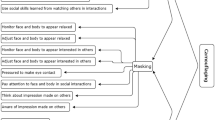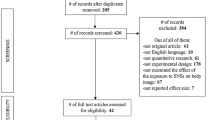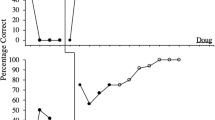Abstract
We investigated persuasiveness as a social outcome of the ability to produce a deliberate Duchenne smile in a role-play task and of a participant’s use of a Duchenne smile while persuading someone in a live interaction. Participants were tasked with persuading an experimenter to drink a pleasant and unpleasant tasting juice as well as not drink a pleasant and unpleasant juice while being videotaped. Participants’ deliberate Duchenne smiling ability was measured by asking participants to smile while acting out “genuine happiness” and also to mask imagined negative affect with a smile. Smiles in the deliberate Duchenne smiling task and the persuasion task were coded for presence of the Duchenne marker, and naïve viewers of the persuasion task made ratings of how pleasant they thought the juice was. Results showed further evidence that a sizeable minority of people can deliberately produce a Duchenne smile and showed that those with this ability are more persuasive. When persuading to drink the pleasant tasting juice, the correlation between the ability to produce a deliberate Duchenne smile and persuasion was partially due to the use of the Duchenne smile while persuading, but this was not the case with the unpleasant tasting juice. When persuading to drink the unpleasant juice, participants who could deliberately put on the Duchenne smile were more persuasive but their persuasiveness was not the result of using a Duchenne smile during the persuasion task.

Similar content being viewed by others
Notes
Twenty-three of the participants in the present study had also completed the deliberate Duchenne role-play task in a previous unpublished study conducted in 2011. Their performance on the task the year earlier was correlated with the performance in the present study. Duchenne smiling across all smiling role-plays was correlated from Time 1 to Time 2, r(20) = .62, p < .01. However, this consistency was apparent only for Duchenne smiling in the “genuine happiness” role-plays, r(19) = .61, p < .01. Duchenne smiling in the “fake happiness” role-plays was not correlated between the 2 years, r(19) = .25, p = .25.
These correlations differ from the correlations between persuasion and deliberate Duchenne smiling in the previous section, because they only include people who smiled while persuading. Thus the N dropped in both cases.
References
Bernstein, M. J., Sacco, D. F., Brown, C. M., Young, S. G., & Claypool, H. M. (2010). A preference for genuine smiles following social exclusion. Journal of Experimental Social Psychology, 46, 196–199.
Carroll, J. M., & Russell, J. A. (1997). Facial expressions in Hollywood’s portrayal of emotion. Journal of Personality and Social Psychology, 72, 164–172.
Ekman, P., & Davidson, R. J. (1993). Voluntary smiling changes regional brain activity. Psychological Science, 4, 342–345.
Ekman, P., & Friesen, W. V. (1982). Felt, false, and miserable smiles. Journal of Nonverbal Behavior, 6, 238–252.
Ekman, P., Friesen, W. V., & Hager, J. C. (2002). The Facial Action Coding System (2nd ed.). Salt Lake City, UT: Research Nexus eBook.
Ekman, P., Friesen, W. V., & O’Sullivan, M. (1988). Smiles when lying. Journal of Personality and Social Psychology, 54, 414–420.
Elfenbein, H. A., Beaupré, M., Lévesque, M., & Hess, U. (2007). Toward a dialect theory: Cultural differences in the expression and recognition of posed facial expressions. Emotion, 7, 131–146.
Feldman, R. S., Tomasian, J. C., & Coats, E. J. (1999). Nonverbal deception abilities and adolescents’ social competence: Adolescents with higher social skills are better liars. Journal of Nonverbal Behavior, 23, 237–249.
Fernández-Dols, J. M., & Ruiz-Belda, M. A. (1995). Are smiles a sign of happiness? Gold medal winners at the Olympic Games. Journal of Personality and Social Psychology, 69, 1113–1119.
Frank, M. G., & Ekman, P. (1993). Not all smiles are created equal: The differences between enjoyment and nonenjoyment smiles. Humor, 6, 9–26.
Fridlund, A. J. (1997). The new ethology of human facial expressions. In J. A. Russell & J. M. Fernandez-Dols (Eds.), The psychology of facial expression (pp. 103–126). London: Cambridge University Press.
Gosselin, P., Perron, M., & Beaupré, M. (2010). The voluntary control of facial action units in adults. Emotion, 10, 266–271.
Gunnery, S. D., Hall, J. A., & Ruben, M. A. (2013). The deliberate Duchenne smile: Individual differences in expressive control. Journal of Nonverbal Behavior, 37, 29–41.
Krumhuber, E. G., & Manstead, A. S. R. (2009). Can Duchenne smiles be feigned? New evidence on felt and false smiles. Emotion, 9, 807–820.
Mehu, M., Little, A. C., & Dunbar, R. M. (2007). Duchenne smiles and the perception of generosity and sociability in faces. Journal of Evolutionary Psychology, 5, 183–196.
Peace, V., Miles, L., & Johnston, L. (2006). It doesn’t matter what you wear: The impact of posed and genuine expressions of happiness on product evaluation. Social Cognition, 24, 137–168.
Smith, M. C., Smith, M. K., & Ellgring, H. (1996). Spontaneous and posed facial expression in Parkinson’s disease. Journal of the International Neuropsychological Society, 2, 383–391.
Thibault, P., Gosselin, P., Brunel, M., & Hess, U. (2009). Children’s and adolescents’ perception of the authenticity of smiles. Journal of Experimental Child Psychology, 102, 360–367.
Woodzicka, J. A. (2008). Sex differences in self-awareness of smiling during a mock job interview. Journal of Nonverbal Behavior, 32, 109–121.
Acknowledgments
The authors thank Matthew Poon, Jessica Katz, and Emily Dahlgaard for helping to conduct the studies and for video editing; Mollie Ruben for assistance with FACS coding; and Jin Goh for comments on a previous version of the manuscript.
Author information
Authors and Affiliations
Corresponding author
Rights and permissions
About this article
Cite this article
Gunnery, S.D., Hall, J.A. The Duchenne Smile and Persuasion. J Nonverbal Behav 38, 181–194 (2014). https://doi.org/10.1007/s10919-014-0177-1
Published:
Issue Date:
DOI: https://doi.org/10.1007/s10919-014-0177-1




